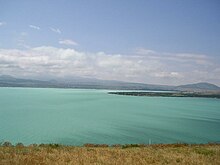Hakob Sanasaryan
After graduation he worked about three years in the L. A. Mnjoyan Institute of Fine Organic Chemistry of the Academy of Sciences of Armenian SSR as a junior scientist.
Beginning in the 1930s, the government of the Soviet Union started diverting Lake Sevan's waters to the Hrazdan River for irrigation in the Ararat Valley and for hydroelectric power generation.
This friendship led to a successful campaign in 1985-1987: they brought a halt to the construction of a highly secretive underground dumpsite for radioactive waste near the Armenian Nuclear Power Station in the Ararat Valley, 30 km away from Armenia's capital city of Yerevan.
This was mainly also thanks to the cooperation of a number of scientists in the Academy of Sciences of USSR: Academicians Boris Sergeyevich Sokolov, Nikolay Enikolopov (Enikolopyan), Tigran Sergeevitsj Hatsjatoerov, Abel Aganbegyan, Samvel Samvelovich Grigoryan, Levon Chailakhyan, Alexander Yanshin, Nikita Moiseyev, Valery Legasov, Nikolai Pavlovich Lavyorov, Aleksey Vladimirovich Yablokov and Evgenii Mikhailovich Sergeev.
He also expressed concern about the location of the site which he believed would affect the nature of soil composition in the area and makes it susceptible to dangerous landslides.
With a discussion in which the Deputy Minister of Trade and Economic Development Gagik Vardanyan was involved it was indeed confirmed under Armenian legislation, that it was unlawful to build a mining factory even within a radius of 50 kilometers of Lake Sevan.

